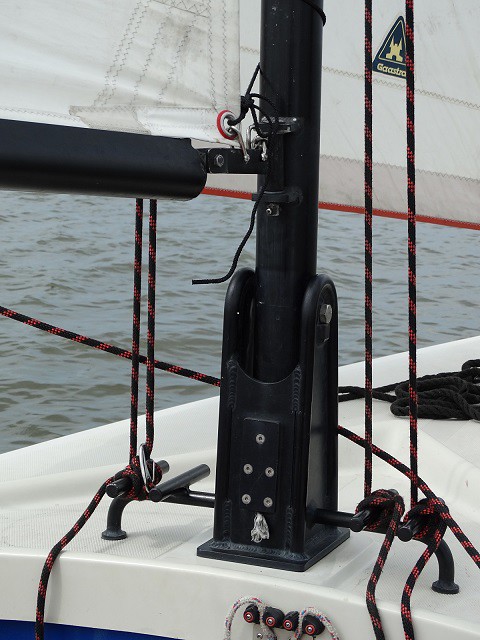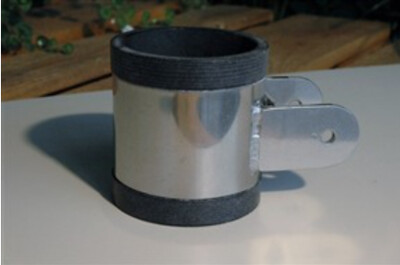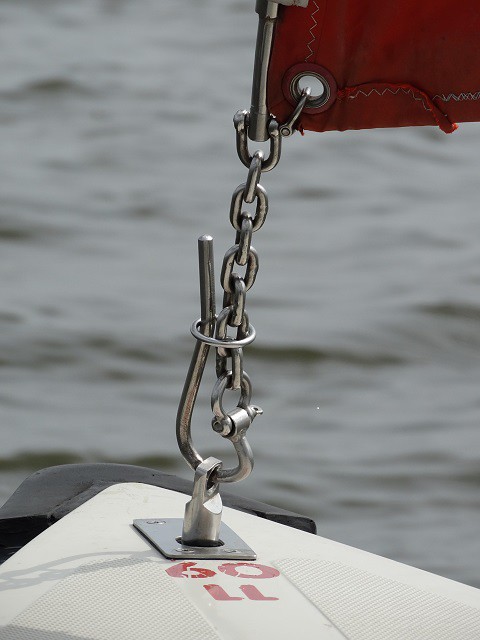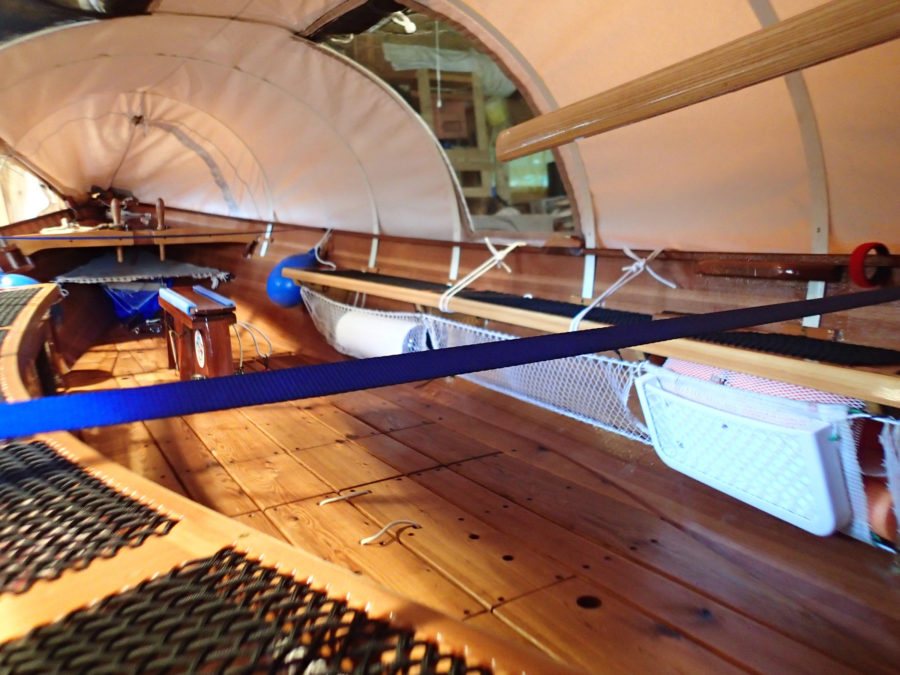Results 31 to 45 of 59
-
13th December 2020, 08:00 AM #31
 Novice
Novice











- Join Date
- Dec 2020
- Location
- VT
- Posts
- 10

The Hartley 21 is almost 8 feet wide, and displaces 2300lbs, while the Jewell is 7’ 4”/ 2.2 m in beam, displacing 1500 lb. These are big boats compared to most sail and oar types. It sounds like Joost is thinking along the lines of an open-ish S&O boat, likely at the larger end of that type’s spectrum, still smaller than a jewell or Hartley.
I am very nearly through building a Jewell, and as Joost mentions, even a simple rig requiring standing rigging becomes a different kettle of fish from an unstayed S&O boat at the ramp or getting under a low bridge. Not that standing rigging precludes ease and efficiency in those places, but the rigging is definitely another layer of complication to consider at the outset. I am planning a tall tabernacle and carbon spars for my Jewell, with the idea that the roller reefed jib will stay attached, with bundled sails protected over the road by sail covers. The goal is a boat as quick at the ramp as my Ilur with an unstayed lug yawl rig. We’ll see how that goes this coming season, There are examples of boats set up along these lines—John Harris’ Pocketship, B&B’s Princess sharpie, and the Norwalk Island sharpies all use tall tabernacles with the bundled sails staying nearly ready to go when not in use.
-
13th December 2020 08:00 AM # ADSGoogle Adsense Advertisement
- Join Date
- Always
- Location
- Advertising world
- Posts
- Many
-
13th December 2020, 01:09 PM #32

I agree with 1st paragraph but I'm trying to make sure we are all on same page.
As far as Jewell, John Hartmann, Clint Chase, and Vivier are actually redesigning the tabernacle and coming up with neat ideas to drop the rig quickly specifically for shooting bridges. But yes, the rowing is not going to be pleasant. I plan on an outboard for it. But I will have headroom and bunks and plenty of cockpit space which is nice to have on cruise where docking is not really a possibility.
I love the Seil. If I lived somewhere with slightly less wild water that would be a boat of choice for me, I think. I've seen some very nice big sleeping platforms. I really love that boat.
-
13th December 2020, 11:26 PM #33
 Novice
Novice











- Join Date
- Dec 2020
- Location
- VT
- Posts
- 10

Somewhere on Vivier’s website is a picture of two (young, strong, smiling) French sailors rowing one of the original Stir Vens, which are bigger and heavier than the Jewell, sitting side by side on the bridge deck, rowing Roman galley style. I think rowing a 1500 lb boat any distance in anything other than a current free flat calm, especially solo, is not a realistic option, and stowing oars of sufficient length for a 7&1/2 foot wide boat would also be a challenge. I will definitely experiment with a break down yuloh on my boat, but for any distance, or conditions other than calm, a boat of this ilk is likely to need an outboard. Dudley Dix, Welsford and Vivier have nice examples of pocket cruisers with very tidy wells which keep the motors ahead of the rudder blade, and covered for sound insulation to varying degrees. Nice not to have an iron mizzen hanging off an otherwise attractive transom as well.
-
14th December 2020, 05:24 AM #34
 SENIOR MEMBER
SENIOR MEMBER











- Join Date
- Apr 2008
- Location
- Tilburg, the Netherlands
- Age
- 51
- Posts
- 519

Yes correct.
A tall tabernacle is needed for rowing but gives a lot of windage with the rig high up. Here in the Netherlands one typically needs to drop and raise the entire rig a couple of times a day during cruising clearing bridges. The polyester Valk is the boat used for rental, cruising and sailing schools and have perfected this over decades and many revisions. The tabernacle needs to be low as to clear the bridges (bridges may be as low as 100cm and will only open for cabin boats or if you are truly unable to go underneath without opening the bridge). This is how they handle this (all photos taken of the boat we rented this summer for a 10 day cruise, save for the gaff connection):
1. Low tabernacle with a spring loaded mast. This allows one to set or strike the mast almost effortless. A big improvement from the past when we had to walk up the mast which was heavy work. Standing and running rigging is kept to the minimum and all is bullet proof so an inexperienced crew cannot damage anything really. There are two systems applied. One uses a pneumatic system (I have never sailed a Valk having that system); the other system uses a piece of dyneema that loads a spring (schematic below). The latter system works very nicely in my experience. The pneumatic system is more complicated using a big lever to fixate the system.


2. The connection of the boom to the mast allows the boom to swivel underneath the mast when the mast is down. Note that the swivel point is quite far back, this is to allow the gaff to swivel parallel to the mast between the boom and the mast when you strike the mast. The boats use a simple stainless steel crutch to support the boom, gaff and mast when it is down.

3. The gaff connection to the mast does not use the standard jaws or pad but rather a pvc lined short tube that goes around the mast. The gaff is connected to this with a bolt which allows the gaff to swivel under the mast when you strike the mast.

4. All the polyester boats use a jib on a roller nowadays. When you need to diminish the sail area, you put in reefs in the main. Originally the boat had a larger genoa as well as a smaller jib, but for cruising the jib on a roller is so much more convenient. Our boat had the roller under deck, some have the roller above deck.
 DSC02529 copy
DSC02529 copy
-
14th December 2020, 05:36 AM #35
 SENIOR MEMBER
SENIOR MEMBER











- Join Date
- Apr 2008
- Location
- Tilburg, the Netherlands
- Age
- 51
- Posts
- 519

I have sailed much with an outboard hung from the transom. If the transom is low enough and provides good access to the tiller not much of a problem in my opinion having it offset to one side clearing the rudder.
A well is nice but also has it disadvantages: smaller outboards (2-3 hp) often need to be pivoted 180 degrees to reverse and a well may prevent one from doing this, it requires a more difficult elaborate construction, more resistance unless having a special plug. Also steering with the engine makes for a far smaller turning circle which is nice when having to manoeuvre in tight spots.
Again, it depends on the type of boat. On a more substantial boat like a Jewell a well makes more sense in my opinion than on a boat like a Hartley 16 or Cherry 16.
-
14th December 2020, 07:12 AM #36
 Novice
Novice











- Join Date
- Dec 2020
- Location
- VT
- Posts
- 10

Joost, thanks for those images and the description of the tabernacle and gooseneck on the Valk, they will provide much food for thought.
I agree that a even a nicely sorted motor well creates some issues even as it solves others; these things become a series of prioritizations, choices, and balancing compromises.
-
14th December 2020, 10:20 AM #37
 SENIOR MEMBER
SENIOR MEMBER











- Join Date
- Apr 2008
- Location
- Tilburg, the Netherlands
- Age
- 51
- Posts
- 519

Not a Valk but the same system (and fittings it seems) for setting/striking the mast:
Damarin 19 Daysailer met Easy mast lift system. - YouTube
Normally it does not make a noise! There are big nylon washers between the tabernacle and the mast itself. Anyway, food for thought for a larger boat with an heavier mast. As you can see it is very light work.
I tried to find more information on the web, but could not find much. I believe that the German manufacturer Sprenger makes the system for the Valks and calls it easy-mast lift system.
-
14th December 2020, 02:34 PM #38

Big thanks for your thinkiing on this John!
Many of Francois' boats fit in this niche. so thankyou for pinning down your experience too.
The interesting thing for me is how much of the boat is taken up with flotation. This does need to be designed in and leave enough storage space for some parts of the world. it is not a trivial problem either.
It seems like a boat that is a little bit bigger runs on so many legal requirements that quite a part of the advantage of bigger boats is lost.
We will keep plugging away in light of all this and see what we can come up with.
MIK
MIK
-
14th December 2020, 02:47 PM #39

I want to get some images down of boats i am less familiar with that are part of the discussion.
Vivier Jewell
Vivier Jewell.jpg
Vivier Seil
seil.jpg
Liteboat XP 20
Liteboatxp20.jpg
-
14th December 2020, 03:43 PM #40

I'm not being at all serious with this sketch.
It is a straight blow up of the 14ft Viola to a straight 19ft. Deck at original level but sides taken up by 75mm for freeboard and some space for the recovery stroke when rowing. I haven't changed the rudder position.
That is Christophe (or his chunkier older brother) laying down.
This low freeboard and beam it would probably row ok in medium winds. Stretching it in many other directions will probably make it unrowable.
I was thinking about weight too.
The LiteXP is not so heavy 330lb
Seapearl 600lbs plus water ballast
CY quotes 150kg (330lb)
MIK
-
14th December 2020, 03:54 PM #41

Just a defensive pre-emptive note. I don't like just scaling things up and down ... this is just a drawing to pick to pieces.
Smaller, lighter Simpler, less volume, more easily driven. The things that make the GIS and Viola work well. I am suspicious about the weight with all that deck area. Probably around the 250 to 300 mark.
MIK
-
14th December 2020, 10:32 PM #42
 Novice
Novice











- Join Date
- Dec 2020
- Location
- VT
- Posts
- 10

Mik, I think the decks are worth the extra weight. One of the main ways water comes aboard the Ilur (and I am sure the Seil also, which is a much lower freeboard board) is spray coming over the rail when sailing to weather in a chop, something we see a great deal of in New England waters. Even the Ilur, which is a deep enough boat for crew to sit very comfortably on the floors, will let wave tops crest the rail when you’re punching along in rowdy conditions. That water makes keeping people and gear dry over multi day trips a bigger challenge. The decks would keep a good deal of that spray off of gear and out of the crew’s face.
-
15th December 2020, 01:12 AM #43

No way my boat is 330lbs. Built out of sapele or meranti plywood, I think. Possibly closer to 500lbs just for the hull.
I really like the CY in "rowdy" conditions. She is dry, even without side decks. Her huuuge garboard contributes to that, I think and the flaring sides. I find her wonderfully stable. She points badly, but I'm still not convinced I can't fix it (I sound like a smitten girlfriend with a damaged-goods boyfriend) and she tacks with difficulty in aforementioned rowdy conditions, but again, I think I can fix this too (trimming of skeg, for one). Reaching and off the wind sailing is top notch, and not scary.
That all aside, it's the interior design that just beggars belief. I don't know if any of you have looked at the this article:
FALCONE de PALU - Small Boats Magazine
But they tossed all the interior furniture and got a big easy-to-navigate platform. This is very appealing, because it's like a blank slate, if you will and any sailor can project their own solutions onto it.
-
15th December 2020, 05:35 PM #44

A most compelling image from the article link posted by Christophe

-
15th December 2020, 09:28 PM #45
 SENIOR MEMBER
SENIOR MEMBER











- Join Date
- Apr 2008
- Location
- Tilburg, the Netherlands
- Age
- 51
- Posts
- 519

For proper sleeping for two, you will need 125cm minimum at the shoulders (140 would be better). Near the feet, it can be a bit narrower.
A Vivier Seil here in the Netherlands has been modified a lot, much in the style of the Harrier presented in the Small Boats Article. Let me try to find a photo of it. The owner first decided (almost a decade ago already - he seriously hurt his sitting bone whilst rowing in a raid in Italy to the extent that he was hospitalized!) to convert the boat to Venetian style rowing (before they tried sliding seats and then fixed seated rowing).
Some 5 years ago maybe, the owner had the normal swinging center board case removed and replaced by a simple dagger board (actually my Goat Island Skiff inspired him to do this). The board is extremely heavy though made from mahogany plywood and being very thick (NACA profile was used). It does mean that the boat is now very much open which is good for camp cruising.
One thing that I do not like about the interior of the boat being completely open is that you are still stuck with waterproof bags all over the boat that you need to strap down. And where is the buoyancy?
Similar Threads
-
Ocean Explorer - Nano Cruising boat from Perttu and Boatmik
By Boatmik in forum Michael Storer Wooden Boat PlansReplies: 87Last Post: 15th August 2012, 03:55 PM -
New Storer Boat Plans?
By Joost in forum Michael Storer Wooden Boat PlansReplies: 3Last Post: 21st April 2009, 04:20 AM -
Storer in Wooden Boat
By seajak in forum Michael Storer Wooden Boat PlansReplies: 4Last Post: 1st February 2009, 11:17 AM -
Storer Boat Photos - Launchings and others
By Boatmik in forum Michael Storer Wooden Boat PlansReplies: 8Last Post: 8th August 2008, 03:06 AM



 Thanks:
Thanks:  Likes:
Likes:  Needs Pictures:
Needs Pictures:  Picture(s) thanks:
Picture(s) thanks: 
 Reply With Quote
Reply With Quote
